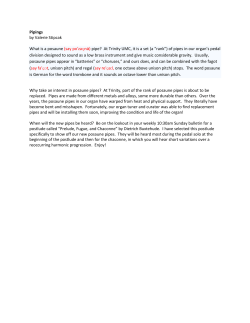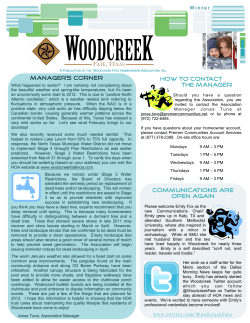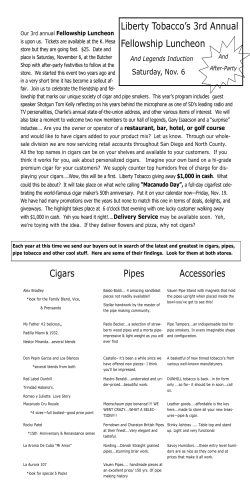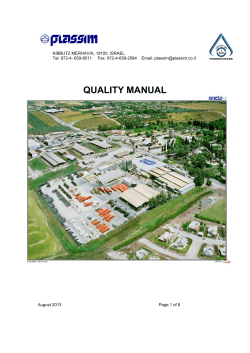
Freezing and Bursting Pipes
Freezing and Bursting Pipes How pipes freeze and burst, and what to do to prevent damage. When water freezes, it expands. That’s When is it Cold Enough to Freeze? why a can of soda explodes if it’s put When should homeowners be alert to the danger of freezing into a freezer to chill quickly and forpipes? That depends, but in southern states and other areas gotten. When water freezes in a pipe, where freezing weather is the exception rather than the rule where houses often do not provide adequate built-in proit expands the same way. If it expands (and tection), the “temperature alert threshold” is 20 degrees F. enough, the pipe bursts, water escapes and serious damage results. This threshold is based upon research conducted by the WHY PIPES BURST Surprisingly, ice forming in a pipe does not typically cause a break where the ice blockage occurs. It’s not the radial expansion of ice against the wall of the pipe that causes the break. Rather, following a complete ice blockage in a pipe, continued freezing and expansion inside the pipe causes water pressure to increase downstream -- between the ice blockage and a closed faucet at the end. It’s this increase in water pressure that leads to pipe failure. Usually the pipe bursts where little or no ice has formed. Upstream from the ice blockage the water can always retreat back towards its source, so there is no pressure build-up to cause a break. Water has to freeze for ice blockages to occur. Pipes that are adequately protected along their entire length by placement within the building’s insulation, insulation on the pipe itself, or heating, are safe. Building Research Council at the University of Illinois. Field tests of residential water systems subjected to winter temperatures demonstrated that, for un-insulated pipes installed in an unconditioned attic, the onset of freezing occurred when the outside temperature fell to 20 degrees F or below. This finding was supported by a survey of 71 plumbers practicing in southern states, in which the consensus was that burstpipe problems began to appear when temperatures fell into the teens. However, freezing incidents can occur when the temperature remains above 20 degrees F. Pipes exposed to cold air (especially flowing air, as on a windy day) because of cracks in an outside wall or lack of insulation are vulnerable to freezing at temperatures above the threshold. However, the 20 degrees F “temperature alert threshold” should address the majority of potential burst-pipe incidents in southern states. REGIONAL DIFFERENCES Generally, houses in northern climates are built with the water pipes located on the inside of the building insulation, which protects the pipes from subfreezing weather. However, extremely cold weather and holes in the building that allow a flow of cold air to come into contact with pipes can lead to freezing and bursting. Water pipes in houses in southern climates often are more vulnerable to winter cold spells. The pipes are more likely to be located in unprotected areas outside of the building insulation, and homeowners tend to be less aware of freezing problems, which may occur only once or twice a season. Pipes in attics, crawl spaces and outside walls are all vulnerable to freezing, especially if there are cracks or openings that allow cold, outside air to flow across the pipes. Research at the University of Illinois has shown that “wind chill,” the cooling effect of air and wind that causes the human body to lose heat, can play a major role in accelerating ice blockage, and thus bursting, in water pipes. Holes in an outside wall where television, cable or telephone lines enter can provide access for cold air to reach pipes. The size of pipes and their composition (e.g., copper or PVC) have some bearing on how fast ice forms, but they are relatively minor factors in pipe bursting compared with the absence of heat, pipe insulation and exposure to a flow of subfreezing air. Water pipes in houses in southern climates often are more vulnerable to winter cold spells. MITIGATING THE PROBLEM Water freezes when heat in the water is transferred to subfreezing air. The best way to keep water in pipes from freezing is to slow or stop this transfer of heat. Ideally, it is best not to expose water pipes to subfreezing temperatures, by placing them only in heated spaces and keeping them out of attics, crawl spaces and vulnerable outside walls. In new construction, proper placement can be designed into the building. In existing houses, a plumber may be able to re route at-risk pipes to protected areas, although this may not be a practical solution. If the latter is the case, vulnerable pipes that are accessible should be fitted with insulation sleeves or wrapping (which slows the heat transfer), the more insulation the better. It is important not to leave gaps that expose the pipe to cold air. Hardware stores and home centers carry the necessary materials, usually in foam rubber or fiberglass sleeves. Better yet, plumbing supply stores and insulation dealers carry pipe sleeves that feature extra-thick insulation, as much as 1 or 2 inches thick. The added protection is worth the extra cost. Cracks and holes in outside walls and foundations near water pipes should be sealed with caulking to keep cold wind away from the pipes. Kitchen and bathroom cabinets can keep warm inside air from reaching pipes under sinks and in adjacent outside walls. It’s a good idea to keep cabinet doors open during cold spells to let the warm air circulate around the pipes. Electric heating tapes and cables are available to run along pipes to keep the water from freezing. These must be used with extreme caution; follow the manufacturer’s instructions carefully to avoid the risk of fire, and check to make sure the product conforms to UL 2049. Tapes and cables with a built-in thermostat will turn heat on when needed. Tapes without a thermostat have to be plugged in each time heat is needed, and may be forgotten. GOING ON A TRIP When away from the house for an extended period during the winter, be careful how much you lower the heat. A lower temperature may save on the heating bill, but there could be a disaster if a cold spell strikes and pipes that normally would be safe, freeze and burst. A solution is to drain the water system. This is the best safeguard. With no water in the pipes, there is no freezing. This remedy should be considered even when the homeowner is not leaving but is concerned about a serious overnight freeze. To drain the system, shut off the main valve and turn on every water fixture (both hot and cold lines) until water stops running. It’s not necessary to leave the fixtures open, since the system is filled mostly with air at that point and not subject to freezing. When returning to the house, turn on the main valve and let each fixture run until the pipes are full again. LETTING THE WATER RUN Letting a faucet drip during extreme cold weather can prevent a pipe from bursting. It’s not that a small flow of water prevents freezing; this helps, but water can freeze even with a slow flow. Rather, opening a faucet will provide relief from the excessive pressure that builds between the faucet and the ice blockage when freezing occurs. If there is no excessive water pressure, there is no burst pipe, even if the water inside the pipe freezes. A dripping faucet wastes some water, so only pipes vulnerable to freezing (ones that run through an unheated or unprotected space) should be left with the water flowing. The drip can be very slight. Even the slowest drip at normal pressure will provide pressure relief when needed. Where both hot and cold lines serve a spigot, make sure each one contributes to the drip, since both are subjected to freezing. If the dripping stops, leave the faucet(s) open, since a pipe may have frozen and will still need pressure relief. IF YOU SUSPECT A FROZEN PIPE If you open a faucet and no water comes out, don’t take any chances. Call a plumber. If a water pipe bursts, turn off the water at the main shut-off valve (usually at the water meter or where the main line enters the house); leave the faucet(s) open until repairs are completed. Don’t try to thaw a frozen pipe with an open flame; as this will damage the pipe and may even start a building fire. You might be able to thaw a pipe with a handheld hair dryer. Slowly apply heat, starting close to the faucet end of the pipe, with the faucet open. Work toward the coldest section. Don’t use electrical appliances while standing in water; you could get electrocuted. When away from the house for an extended period during the winter, be careful how much you lower the heat. A lower temperature may save on the heating bill, but there could be a disaster if a cold spell strikes and pipes that normally would be safe, freeze and burst. WHAT TO DO DURING FREEZING TEMPERATURES IN SOUTHERN CLIMATES Water damage from frozen pipes that burst can be a major problem for homeowners in southern states, maybe even a bigger problem than in the colder north. Home builders in the south often do not consider the threat of freezing weather and thus place water pipes in vulnerable locations. In addition, houses built on slab foundations, common in the south, frequently have water pipes running through the attic, an especially vulnerable location. In the north, by contrast, home builders know freezing is a threat, and they usually do not place water pipes in unheated portions of a building or outside of insulated areas. Southern homeowners should be aware that pipes in attics, crawl spaces and outside walls are all subject to freezing and bursting. If these pipes don’t have insulation or heat to protect them, a strong overnight freeze can cause trouble. Homeowners in the south need to be alert to the damages of freezing and bursting water pipes when the outdoor temperature threatens to drop to 20 degrees F. Although 20 degrees F is well below the freezing temperature of water, two factors make this the critical outdoor temperature: 1. The temperature of an unheated portion of a house is almost always at least a few degrees above the outdoor temperature. For example, an insulated attic may be at 37 degrees or 38 degrees F when the outdoor temperature is 32 degrees F. 2. Water “supercools” several degrees below freezing before any ice begins to form. In research tests at the University of Illinois, water pipes placed in an unheated, insulated attic consistently started forming ice when the outdoor temperature dipped just below 20 degees F. The 20 degrees F threshold is primarily for homes in the south and other areas where freezing may occur only once or twice a season. These suggestions for homeowners in southern states will help them prevent freezing pipe damage: • Pipes in attics and crawl spaces should be protected with insulation or heat. Pipe insulation is available in fiberglass or foam sleeves. Home centers and hardware stores have sleeves providing 1/8 to 5/8 inches of insulation; specialty dealers have products that provide up to 2 inches of insulation. (Check the Yellow Pages under “Insulation” or “Plumbing Supplies” for sources.) • Heating cables and tapes are effective in freeze protection. Select a heating cable with the UL label and a built-in thermostat that turns the heat on when needed (without a thermostat, the cable has to be plugged in each time and might be forgotten). Follow the manufacturer’s instructions closely. • Doors on cabinets under kitchen and bathroom sinks should be left open during cold spells to allow the warmer air of the room to circulate around the pipes. • Exterior pipes should be drained or enclosed in 2-inch fiberglass insulation sleeves. • Pipes leading to the exterior should be shut off and drained at the start of the winter. If these exterior faucets do not have a shut-off valve inside the house, have one installed by a plumber. • Hoses should be removed and stored inside during the winter. • Let faucets drip slowly to keep water flowing through pipes that are vulnerable to freezing. Ice might still form in the pipes, but an open faucet allows water to escape before the pressure builds to where a pipe can burst. If the dripping stops, it may mean that ice is blocking the pipe; keep the faucet open, since the pipe still needs pressure relief. More Information Additional freezing weather guidance can be found at DisasterSafety.org/Freezing_Weather South Carolina Farm Bureau Mutual Insurance Company® • Southern Farm Bureau Casualty Insurance Company Southern Farm Bureau Life Insurance Company, Jackson, MS • Palmetto Casualty Insurance Company
© Copyright 2025









